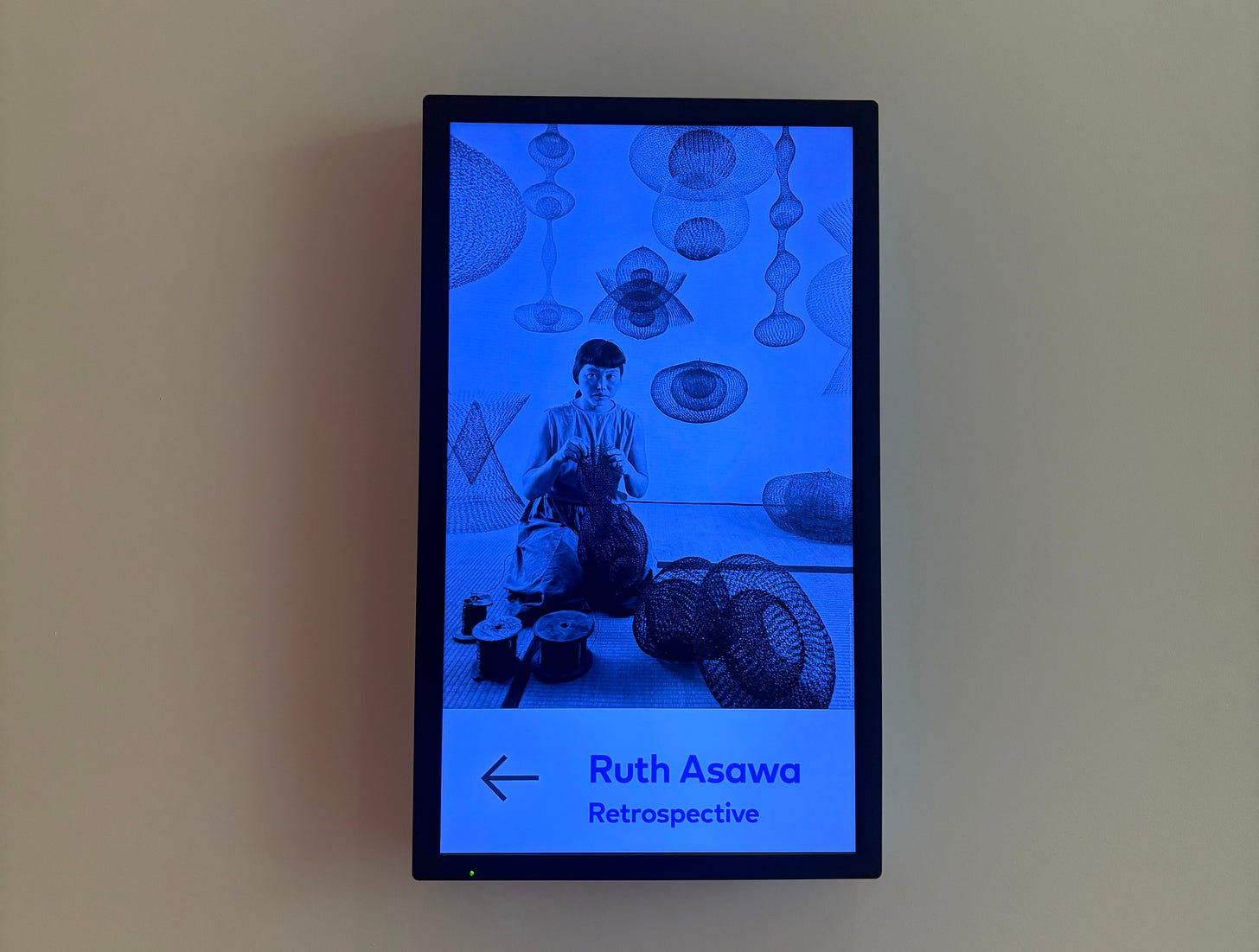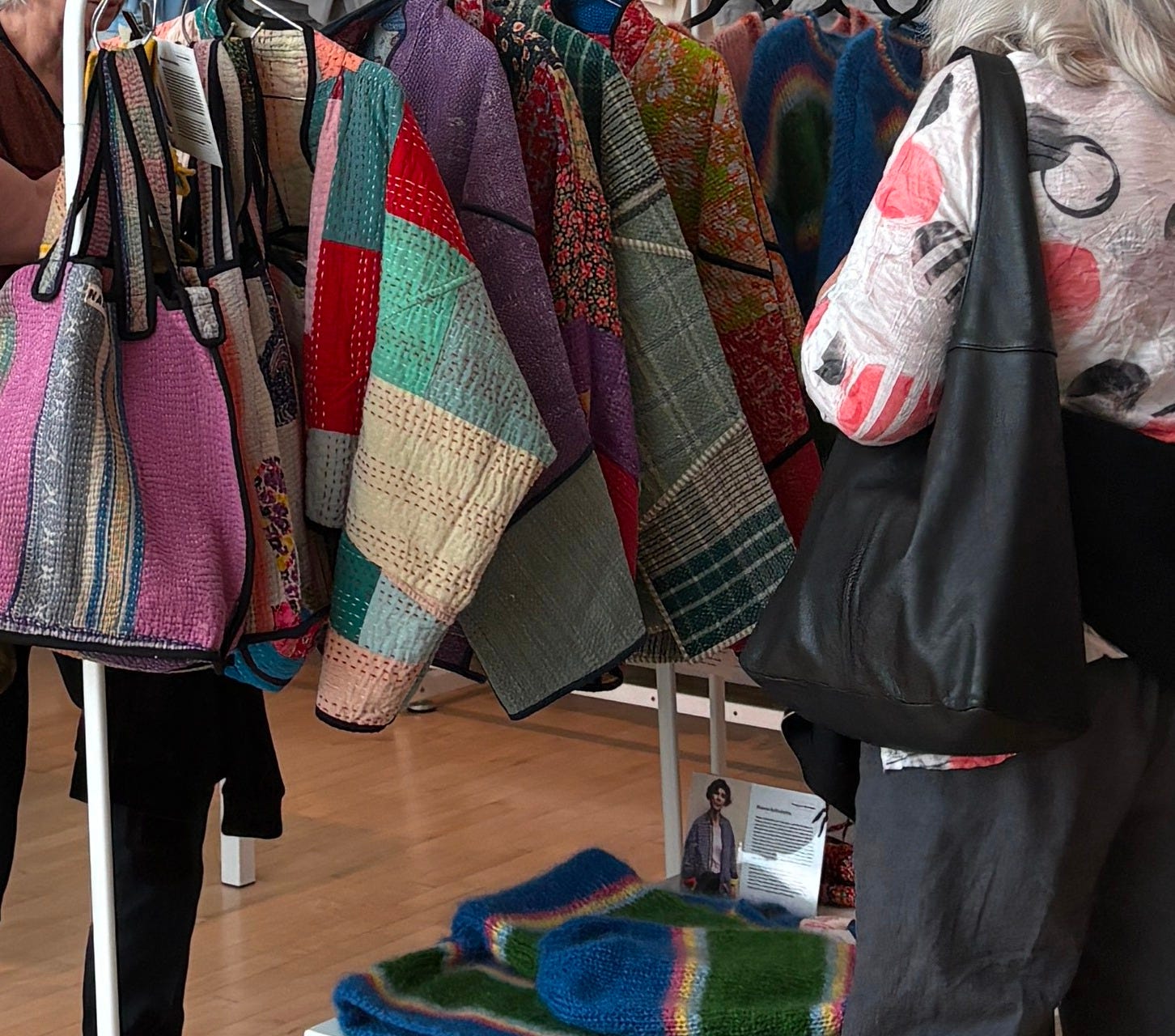what are people wearing at the moma ruth asawa exhibit?
unpacking the west village girl of SF.
This is an installment of my Bay Area style anthropology series. You can read the first one here: what are people wearing at berkeley bowl?
It’s a random Tuesday afternoon in May, and I’m headed to the Ruth Asawa retrospective at SFMOMA.
As the gusty rumbling of the Milbrae train approaches the platform, I hold my bell-shaped wool hat down to keep it from flying away. I board, sink into a seat and lean back, only to jolt upright with germaphobic reflex as the seat makes contact with my bare back. I’d forgotten how low the back of my Pucci top was. So I stand. All the way to Montgomery station, where I get off and weave through empty whirring Waymos and Houlihan Lokey finance bros until I arrive at my destination: the steps of the SFMOMA.
Ever since the exhibit opened last month, it’s been the talk of the town. (Or at least, my corner of the town). I’ve spotted hanging wire sculpture photos on my Substack Notes feed. “You should buy tickets in advance—it sold out when we tried to go,” a friend warned.
The last time there was this much regional hype around an art exhibit was the fucking Museum of Ice Cream pop-up in 2018. Granted, that was a very different sort of museum, and 2018 was a different universe altogether.
The human body undergoes a full cellular regeneration every 7 years, and I’ve always felt the same applies to cities. In the case of San Francisco, a comparison of the museum scene between the 7-year gap from 2018 to 2025 reveals how culture has shifted. The Museum of Ice Cream pop-up represented the peak millennial Instagram era experience: in 2018, you could eat girlboss bread pudding from Tartine at the newly-opened Wing on Sansome, then take “The Future is Female” selfies at 29Rooms by Refinery29 across town).
In 2025, the success of the Asawa show marks a pivot from social media spectacle to local historic substance by celebrating the Japanese-American sculptor’s role as the Patron Saint of San Francisco arts. You learn about Asawa’s lived values as an artist, like community, access, and advocacy. We are reminded of San Francisco’s identity as an arts hub in the 60s and 70s, long before it became the tech capital it is today.
Here’s the twist: the nostalgic nod to the city’s bohemian past now is funded by the very forces that contributed to its erasure.
SFMOMA received $1.5M from Google’s philanthropy arm to support the retrospective, setting a record as the largest corporate donation the museum has ever received for a single show. A tech wealth-funded exhibit honoring Asawa’s community-driven art practice captures the paradox at the heart of this city’s identity.
It’s precisely this cultural tension that makes the SFMOMA an ideal location for a classic Molehill style anthropology breakdown.
At art museums, there is an unspoken understanding that you are to see and be seen. It is one of the few places in the city where people dress up a little bit more.
I spent the afternoon roaming every floor, taking notes on what people were wearing, how they present, and what sort of in-group or subculture they are signaling (intentionally or not!).
Then, I synthesized my notes into a list of style archetypes that felt the most…crystal clear, fully-articulated. Here’s what I came up with:
Gift shop grande dame
Digicam girlie
Reformed tech bro
West village girl (of SF)
+ some honorable mentions.
Below is a preview. The full read is for paid subscribers as these pieces involve a high level of time and effort. It include some affiliate links, only above the paywall.
If you love it, consider supporting my work!
An annual subscription comes out to $1.15/week.
The Gift Shop Grande Dame

She came for the Asawa, but stayed for the limited-edition patchwork stitch jacket. This archetype is usually an older woman, but honestly you can have a gift shop grand dame streak regardless of age or gender. 3 or more of them make up what I call a retired baddie girl group on an arts excursion. (It’s very wholesome).
These grand dames move through the exhibit in floaty patterned clothes, beaming with effusive admiration—this is really remarkable. Ruth Asawa was so multi-talented. will you look at that handiwork!
Unlike my generation, these ladies have ironclad attention spans and actually read every single text placard. Her giant earrings bob up and down as she nods.
Museums are a huge part of her personality, so the gift shop is her retail cathedral. She goes feral over anything with an “art print”—Van Gogh umbrellas, Degas coasters, Monet lily pad silk scarves. While her accessories are always blinged out to the max, her outfits are grounded in practicality and comfort. Think sneakers with arch support (SF hills are no joke), a roomy shoulder bag, a cozy cardigan in case it gets chilly. Her clothing moodboard has a lot of Marimekko, COS, and funky eyewear.
At checkout, she’ll casually mention she’s a *member* at least twice. Once to get the 10% discount, and again to imply that she personally keeps the museum afloat :-)
The Digicam Girlie

While LA is the capital of the digicam girlie, there is a sizable population in pockets of the Bay Area.





